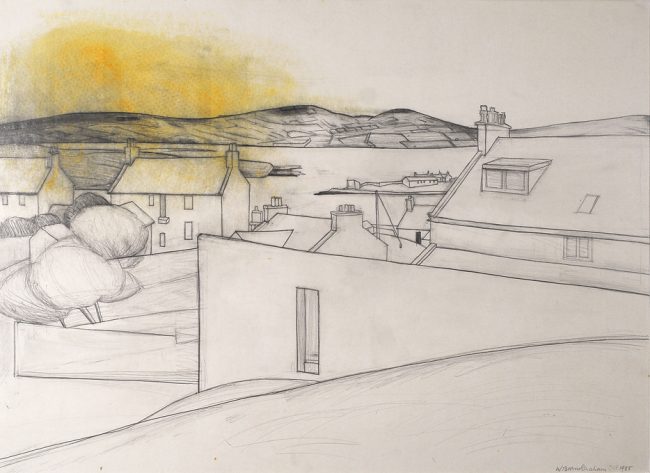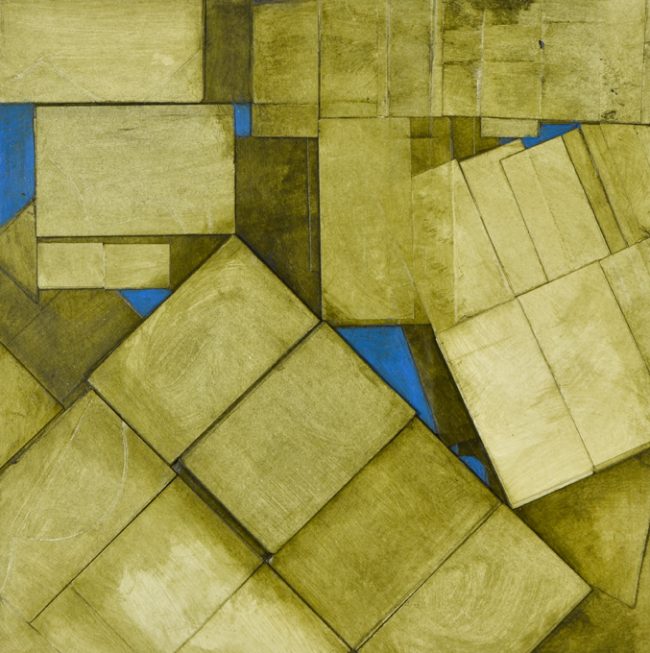Wilhelmina Barns-Graham in Orkney

August in Orkney, 1987, Oil on hardboard, BGT1206
THIS ARTICLE ACCOMPANIES THE ON-LINE DISPLAY – ORKNEY
On 15 August 1984, Wilhelmina Barns-Graham (Willie) boarded the ferry at Scrabster on Scotland’s far northern coast. She was on the final leg of a journey to Stromness to oversee the installation of her exhibition at the Pier Art Centre. Unbeknown to her at that moment was the love affair she was to have with these northern isles. Arriving at Stromness after experiencing “wonderful clear views of Hoy ◦ red ◦ complicated ◦ very rich blue sea”,(note 1) she was met at the pier by “charming Erland Brown with the interesting eyes”, the director of the Pier Art Centre. She went directly to the gallery to assist in the ”sorting out of the rooms” in preparation for the exhibition opening two days later. In her diary Willie reported that at the private view George Mackay Brown, the renowned Orkadian poet, author and dramatist, came up to her to say “ ‘Congratulations I like it’ and I said coming from you that means something to me”. (note 2)
The exhibition W. Barns-Graham: Paintings and Drawings was more or less the selection first presented at the Crawford Arts Centre in 1982, modified for the Pier Art Centre with some deletions and additions, particularly a new collection of collages made during the previous winter. It was a great success. On the day following the opening Willie went out to explore the main island before heading home. However, with a dramatic change of heart, rather than returning to St Andrews, she made the decision to stay, indeed remaining in Orkney for a further seven weeks! Ensconced as Artist in Residence at the Pier she experienced an extraordinary freedom, unfettered from the regularities of her usual studio life. Furthermore she was generously offered the use of Stanley Cursiter’s studio situated just a few doors down from the gallery.
The paintings , drawings and collages to be seen in our online display reflect how deeply inspiring Orkney was to Willie. For anyone who has travelled to these northern islands it is easy to appreciate how the landscape and atmosphere absorbs the visitor. The island landscape provided a new impetus; her reaction to, and clear enjoyment of, this new world manifested itself in her work in a manner not seen since her journeys to Switzerland, Italy and Spain made in the period between 1949 and 1958. When Rowan James, her friend and studio manager, arrived in Orkney by car she was able to travel around much more, taking many photographs with a specially purchased wide format camera in order to capture the horizontality of the landscape and the rock formations. (note 3)
Indeed, such was the pull of Orkney that she returned there the following summer, spending a further six weeks during September-October.
The Orkney collection comprises a range of imagery and media, from relatively straightforward drawings made in situ through to progressively more abstract imagery. Working from drawings and photographs the Orcadian landscape was subsumed into her art practice, translated, as it were, into her visual vocabulary. The evident scope here illustrates well the breadth of vision and the development of her thought processes. That she could work simultaneously within widely different visual styles, between the bounds of the literal and the abstract, indicates how comfortable she was in operating in both spheres, and that she had no, and saw no, difficulty in doing so.
In describing Willie’s drawings the noted art writer Mel Gooding wrote that her drawings are remarkable for their fidelity to the perceived world of appearances. Willie herself stated that she was “…collecting shapes that become my shapes. To see what is useful…..to identify with its rhythm so that, again, later I can express myself in my own language.” (note 4) One can see this taking place in her views of the island hills, the patterning of the fields in the drawings and gouaches of 1984 evolving into more simplified patchwork in those of later years, concluding with the dark, brooding Red Landscape II of 1991.
Of the Orkadian fields Willie commented in her diaries; “….the lovely faces of cattle and swaming [note 5] green patterned and ochres in feminine rhythms and intensely blue weather + sky + happy birds + peace”; “After heavy rain of yesterday + the night it all looking marvellous + the brown heather of the hills, square + oblong emerald fields”; ”I enjoyed lovely possible drawings Birsay area + all looking very green + blue + landscape ochre + brown on left full of possibilities.”
Of similar significance the geology of the island attracted Willie’s interest, echoing her fascination with the sculptural qualities of the Grindelwald Glacier and the underlying structure of the Tuscan landscape of earlier times. Of Yesnaby, on the island’s west coast she writes of “huge dramatic fascinating structures of cliffs in ridges & incredible menacing-enticing atmosphere, it so reminded me of my pc of glacier shelf – it was all in lines”. On another day; “We went [on a]lovely walk in evening to the kirkyard graves facing Hoy below or around from Stromness _ very eerie + an orange evening light cause….anyway the black-rust orange cream rock formations – flagstones – were very close to my collages + interested me as much as anything I had seen….Hoy dark greens & purples.”
This observation of flagstones was made about the beach by Warbeth, a short distance to the south west of the town. As found in other parts around Orkney’s main island, the rock formations here lead out to sea, flat and layered like paving slabs. At Warbeth many of the rocks have a pink/orange hue, while the formations at Birsay, on the north side of the island, tend towards pink, yellow and tan. When seen below the water, the rocks at Birsay, depending on light conditions of the day, can run through a spectrum of yellowy greens and greys. These colour palettes observed at Warbeth and Birsay feature in the collages in the collection. However, as Lynne Green observed, Willie’s “large collages, while a direct response to Orkney, are an uncompromising abstract translation of the artist’s experience. Not just the manner of the relationship of the slabs but the inner logic of their intentions. Colour harmonies and dissonance determine the mood, independent objects of art within their own poetry and power to move.” (note 6)
Willie’s time on Orkney was intense and acutely felt. She loved the islands and was sad to go. “I don’t want to leave. What a happy miraculous visit of 37 days.” She wished she had gone earlier (and younger) in her life. On return home it took some time to re-adjust, her diary entries showing that she’d rather be back there. There is just a hint of suspicion that she would have stayed there forever had that option been at all possible. Orkney – “So much work ideas are here – drawings, colour, shapes, moods, space – elongated shapes + then the light + rock groupings – water movement – changes. It is overwhelming – choked with it all.” “Been getting up early + again this lovely clear peach yellow sky. Won’t forget last nights walk the elongated pink clouds what clarity + softness – a little cloud peeping out behind Hoy. Those almost copper pink reflections in the water one way + the ice cream-white blazing the other…” “Colouring in these parts can change so incredibly quickly – intense….blue on left – look right on a cold grey – that’s the sea. Then seaweeds! Growth, wonderful orange + rusts + olive greens especially after rain. The grey waters too can be two shades of grey sometimes blue grey or yellow grey – the quilted fields at least three shades of green – emerald, bluer, yellower, darker – two shades of ochre bounded by stone walls + on top bound by deep rich brown of the heather. The influence of the sky is into the water….”
In contemplative mode Willie wrote in her diary that “Island life is a school for learning, discipline, acceptance & humility. What you say, think & are – the spoken word, could travel from island to island like [a] stone & its ripple into distance – the elements being so powerful keep you to size – then these beautiful dark half moon shapes of reflection of clouds on the distant fields + hills + ….. give a sense of constant change + re-newal – [of] impermanence.
Notes:
1: All the artist’s quotes come from her diaries of 1984 and 1985. The diaries are part of her archive which is on extended loan to The Special Collections of St Andrews University Library.
2: Indeed, she and Brown (of whom she was in awe) became good friends and sent Christmas cards to each other until his death. His nephew was Erland Brown, the Pier Arts Centre’s director.
3: These photographs are held in the Trust’s photo archive.
4: See A Discipline of the Mind: The Drawings of Wilhelmina Barns-Graham, exhibition catalogue, The Pier Arts Centre/The Barns-Graham Charitable Trust, 2009
5: Swaming – Dizziness, swooning. (Old Scots)
6: Lynne Green, W.Barns-Graham: a studio life, Lund Humphries, 2011, p230.
Geoffrey Bertram
August 2020

Stromness, Orkney No.1 1985 pencil and oil on paper 53.5 x 74.3 cm BGT676

Warbeth 7 1995 acrylic on paper on hardboard 25.6 x 25.5 cm BGT6163
